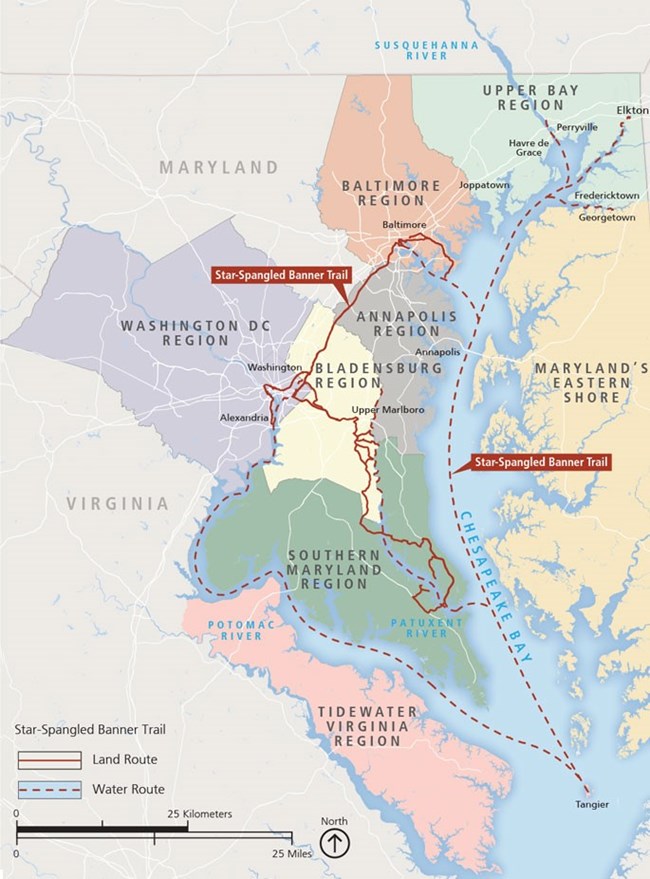
British Land March and WithdrawalBladensburgThe Battle of Bladensburg on August 24, 1814, ended in defeat for the United States and allowed the British to invade Washington, D.C. Once the Americans realized the British route of advance, there was little time to prepare. They hastily established lines of defense near the port town of Bladensburg, where the British would cross the Eastern Branch of the Potomac (known today as the Anacostia).The poorly trained and ill-equipped American militia, though superior in number, were no match for the seasoned British army. That night, as buildings in Washington burned and the victors ravaged the White House, news of the rout at Bladensburg spread throughout the countryside. BostwickBritish officers stopped at Bostwick House on August 24, 1814, then the home of prisoner of war agent Col. Thomas Barclay. From Lowndes Hill, behind the house, British commander Robert Ross observed the American defensive lines. Bostwick House was built in 1746 for Christopher Lowndes, a local shipyard owner. It was later home to his son-in-law Benjamin Stoddert, America’s first Secretary of the Navy.Mount CalvertOn August 22, 1814, explosions erupted on the Patuxent River! The U.S. Chesapeake Flotilla scuttled their own vessels when British pursuers approached.Anchored off Mount Calvert, British Rear Admiral Cockburn reported “the complete destruction of this Flotilla of the Enemy which has lately occupied So much of our attention.” With the flotilla destroyed, the British landed about 500 troops at Mount Calvert. From here they marched to Upper Marlboro to join the main British invasion force. NottinghamNottingham was the Chesapeake Flotilla’s base in July and early August 1814. The town was hastily abandoned on August 21 as the British moved in. An enemy rear guard protected this important landing while the main force invaded Washington. British vessels here took on wounded soldiers and artillery as the Washington campaign ended.“Came...to the town of Nottingham...Not an individual was to be seen in the streets, or remained in the house; while the appearance of the furniture, &c., in some places the very bread left in the ovens, showed that it had been evacuated in great haste.” – British Lt. George Robert Gleig As British troops marched toward Nottingham they discovered two American militiamen who claimed to be out squirrel hunting. They balked when officers asked why they were hunting with bayonets. Riversdale MansionFrom her home on August 24, 1814, Rosalie Stier Calvert saw rocket fire as the Battle of Bladensburg raged two miles away. Soon she would learn of the British victory and know from the reddened skies over Washington that the enemy had reached the city.Her husband George and their ensalved field-hands helped to bury the dead after battle. Mr. Calvert visited injured British officers recuperating in Bladensburg. Upper MarlboroDr. William Beanes, who opposed the war, cooperated with the British when they occupied Upper Marlboro August 22–23, 1814. Beanes reportedly dined with Major General Robert Ross.Later, Ross ordered Beanes taken prisoner for arresting British looters. While helping to negotiate Beanes’s release, Francis Scott Key witnessed the Fort McHenry bombardment and penned lyrics for the “Star-Spangled Banner.” Upper Marlboro is also home to Trinity Church where British soldiers tore pages from the parish register and Darnall’s Chance, the home of John Hodges, the only known person tried for treason during the war. British diversionary feintsFort WashingtonExplosions at Fort Washington August 27, 1814, surprised British and Americans alike. A British squadron slowly making its way up the Potomac expected resistance from the well-positioned fort. Alexandrians, fearing they were next after Washington’s fall three days before, expected protection from the fort.,P. Samuel Dyson, U.S. Army captain in command, decided his 45-man garrison would be no match for the British. He ordered the fort destroyed and was later court-martialed for his decision. “The garrison to our great surprise, retreated from the fort and a short time afterward Fort Washington was blown up, which left the Capitol of America and the populous town of Alexandria open to the squadron without the loss of a man.” --British Captain James Alexander Gordon, August 27, 1814. Mount Welby(now located at Oxon Cove Park and Oxon Hill Farm) Perched above the Potomac River, Mount Welby was nearly surrounded by the war in August 1814. Mary Welby DeButts describes hearing “every fire” from the Battle of Bladensburg and how the house was illuminated by fires in Washington. She writes of finding three congreve rockets “on our hill” and that a British fleet “lay directly before our house.” Mount Welby was in earshot of explosions that destroyed Fort Washington and within view of the plundering of Alexandria.The war was especially hard for Mount Welby’s owners, Dr. Samuel DeButts from Ireland and his wife Mary from England. Unable to access English banks and markets, the British sympathizers struggled to keep their farm. “You know not how it hurt me to think I was so near my Countrymen, and must look upon them as Enemy.” –Mary Welby DeButts to Millicent Welby Ridgehill, March 18, 1815. |
Last updated: May 26, 2020
